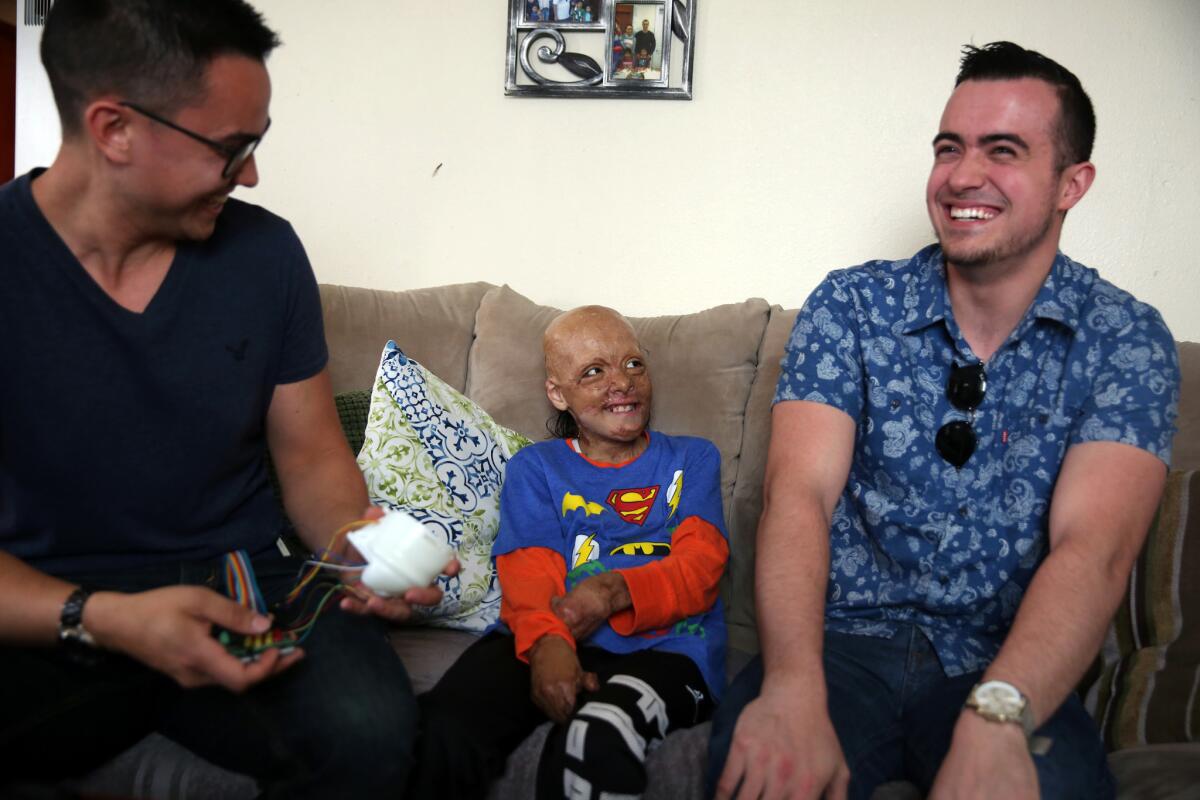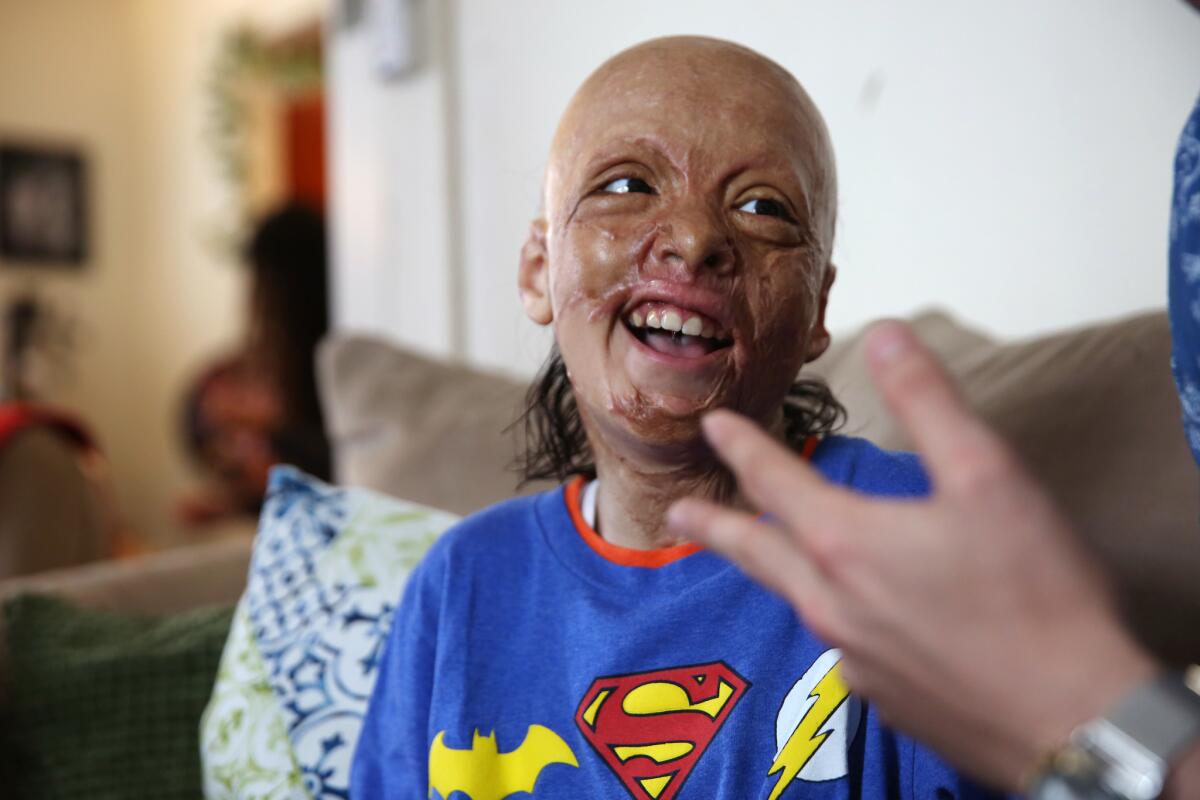Student engineers create bionic hands for a boy burned in a horrendous crash

- Share via
Julian Reynoso is a 10-year-old fourth-grader with big brown eyes and a devilish sense of humor.
When I met him on Saturday, he was sitting on the couch in a cluttered living room in South Los Angeles, playing on his Nintendo Switch. Given that he was severely burned and lost nine fingers last year in a fiery car crash, his motor skills were impressive.
In the kitchen, Julian’s mother, Elizabeth Flores, 34, who was seriously injured in the crash, was fixing his lunch.
Julian’s scars are evident; he was burned over 35% of his body, including his head and neck. He has lost most of his hair, though his thick eyelashes remain. His mother’s scars are less apparent; she suffered a collapsed lung, a torn bowel and terrible bruising.
On this bleak June day, two engineering students from Cal Poly San Luis Obispo were due any minute. Seniors Ryan Kissinger and Austin Conrad were coming down to fit Julian with prosthetic hands, a project they’ve been working on since August.
They arrived with a big black tool box, whose drawers had labels like “bolts,” “thumb,” “socket and finger.” This was their second visit to Julian’s house. The first had been something of a disaster. Almost nothing had worked. But they were not about to give up. They went home and made fixes.
Every year, student teams from the Cal Poly club Quality of Life Plus, or QL+, take on a few projects aimed at improving the lives of people who might be able to use an engineering solution to an extraordinary physical hurdle: a special fin for a competitive swimmer who has lost a leg, a bionic limb for a one-armed nursing student.

Julian came to the attention of QL+ through a Cal Poly student who is a friend of his family. Seventy students applied to be on what they would call the “Midas Project.” Kissinger, the team lead, whittled the number down to eight. For many of those students, creating hands for Julian has become a nearly full-time job, something they are doing in addition to schoolwork. Kissinger was supposed to have graduated this spring. He has put that off for a quarter so he can finish his commitment to Julian.
Julian’s left hand was more severely damaged than his right, so that prosthetic will be far more complicated. The bionic replacement for his left hand will have a battery and tiny motors and little buttons inside that he will be able to activate with the stubs of his fingers to move the 3-D printed fingers. Because the right hand is a simpler mechanism, he tried it on first.
Sitting on the couch between Kissinger and Conrad, Julian slipped his right nub inside the hand they had fashioned for him. It was covered with a black-and-white glove.
With some effort and a big smile, Julian flipped them the bird.
Kissinger and Conrad laughed in relief.
“I don’t have to give you a middle finger, you know!” Kissinger said.
::
Nothing that mother and son went through was as painful as the loss of three family members who were killed in the crash by a man who has been charged with drunken driving.
Juan Reynoso and Elizabeth had met in Santa Barbara, where Elizabeth was earning her bachelor’s degree in Spanish literature. They were together 12 years. He was a self-employed auto mechanic, who was remodeling the family’s kitchen at the time of his death.

Emma Ginger was 7. The baby, 6-month-old Sebastian, was still nursing.
The living room is filled with Emma’s and Sebastian’s things. Elizabeth, a case manager with the L.A. County Housing Authority, can’t bear to move anything just yet. “In honor of our precious baby Sebastian, we are leaving his baby swing in place,” says a note taped to the swing. “Please do not move.”
Between the kitchen and the living room, a shrine to Juan, Emma and Sebastian is covered with photos, images of the Virgin of Guadalupe, lit candles.
After the accident, Julian spent four months in the hospital, first in the burn unit at L.A. County-USC Medical Center, then at Children’s Hospital Los Angeles. Halfway through his stay, Andrew Goslin, who is married to Elizabeth’s cousin, helped arrange a visit from Matt Kemp, the Dodgers outfielder. Goslin, who works at Northrop Grumman and was president of his local Little League, said he knew someone in the Dodgers organization, and had asked for an autographed photo of Kemp.
“Matt was like, ‘Absolutely not. I am not sending a picture. I’m going to the hospital,’” Goslin said. Kemp spent two hours with Julian and his family, and promised he’d have them come to a game when Julian was well enough to attend.
Even after he was traded to the Cincinnati Reds, Kemp kept his commitment. When the Reds played the Dodgers in April, Kemp (who has since been traded to the Mets) invited Julian to throw out the first pitch.
Julian waved to the crowd, then walked out to the mound. Without the help of prosthetic hands, he lobbed a ball toward Justin Turner, who crouched behind the plate.
Over Memorial Day, Elizabeth took Julian to Burn Survivors Camp at Lake Hughes, an annual event organized by the Grossman Burn Center. He did archery and caught six fish.
Which led me to wonder why, since Julian has been able to play on his Switch, toss out a first pitch and even use a pencil without a prosthetic, does he need new hands?

“I see this as a bonus,” Elizabeth said. “He can’t turn knobs, or open a water bottle. I think riding a bike or scooter would be helped.”
Kissinger thinks of the project as something bigger than just a pair of hands.
“We have crafted a metaphor for him and his family,” he told me Monday. “There are people who are compassionate about him, and goodness can triumph over tragedy. Maybe he gets a different prosthetic later, or maybe he doesn’t need one for his left hand at all. We want to be a restorative force.”
As Conrad put it: “This is not engineering for engineering’s sake. We don’t want to build a faster race car. This is an attempt to restore order in chaos.”
::
After Julian was discharged from the hospital, he was home-schooled for six months.
In February, he returned to Harmony Elementary. The Alisa Ann Ruch Burn Foundation hosted three reentry assemblies to prepare students for Julian’s return. His appearance, after all, had changed dramatically since they last saw him.
He has encountered no problems in school and was named student of the month, his mom said. Sometimes, though, when they are out and about, kids stare.
“A little girl asked ‘What happened to you?’” Elizabeth said. “He told her he was in a war in Fortnite.”
On Saturday, the Midas Project is to culminate at a dinner on the Cal Poly campus. Elizabeth, who is not comfortable driving long distances, plans to take the train up with Julian.
Kissinger, Conrad and their team have less than a week to finish the work. And when school ends for the summer, they don’t plan to abandon Julian.
“I want to be your 24/7 tech support,” Kissinger said. Since Julian is still growing, the students think the prosthetics will be usable for him for about two years.
This week, they are working hard on the final details. They don’t want Julian’s hands to look like artificial versions of the ones he lost.They want them to look amazing, futuristic, awesome.
“We want to make something that changes the way he interacts with people,” said Conrad. “We don’t want people to look at him and say ‘What happened to you?’ We want people to look at his hands and say, ‘Wow! What is that?’”
Oh, you know. No big deal. Just a pair of hands from the future.
Twitter: @AbcarianLAT
More to Read
Sign up for Essential California
The most important California stories and recommendations in your inbox every morning.
You may occasionally receive promotional content from the Los Angeles Times.














